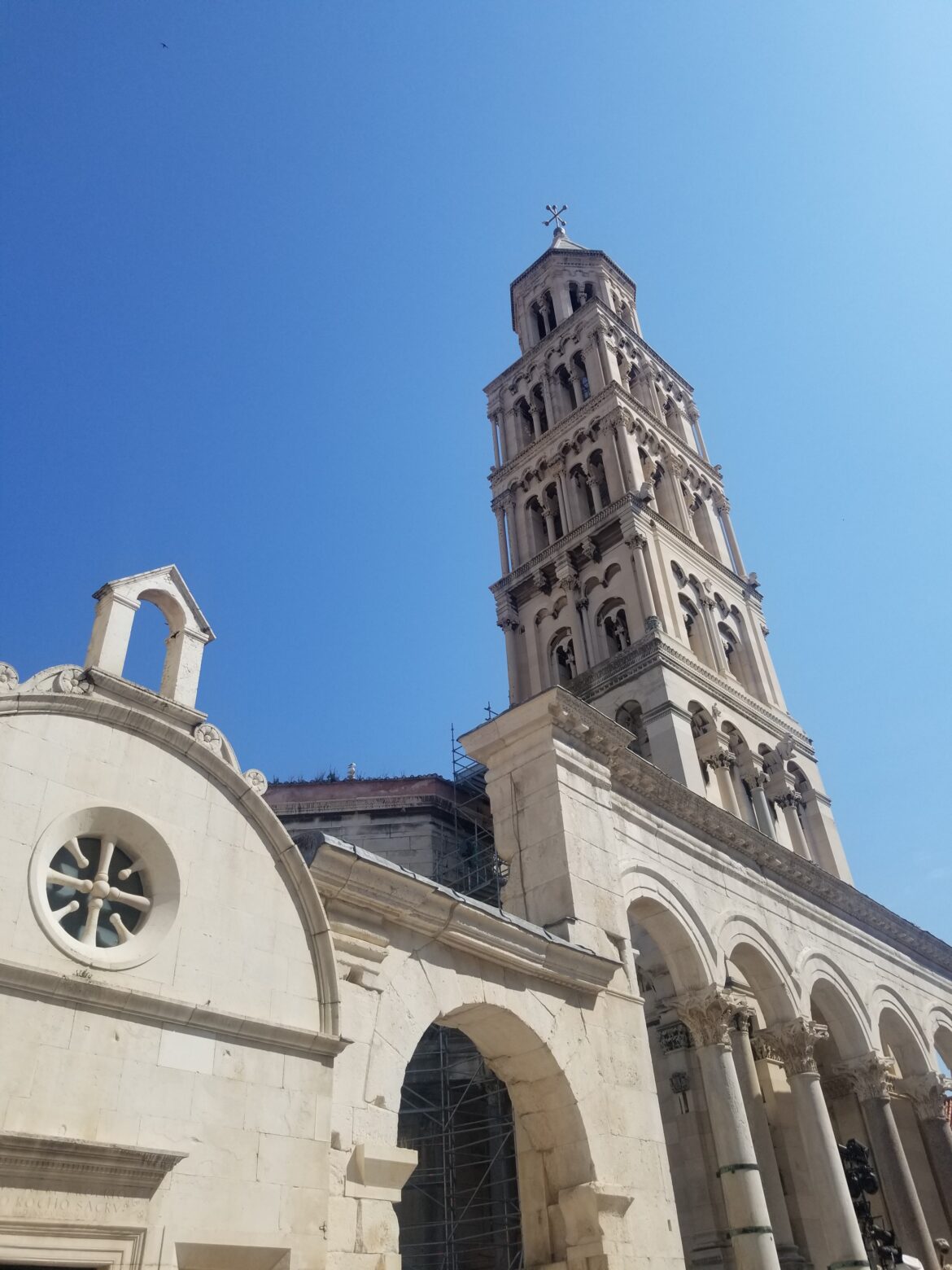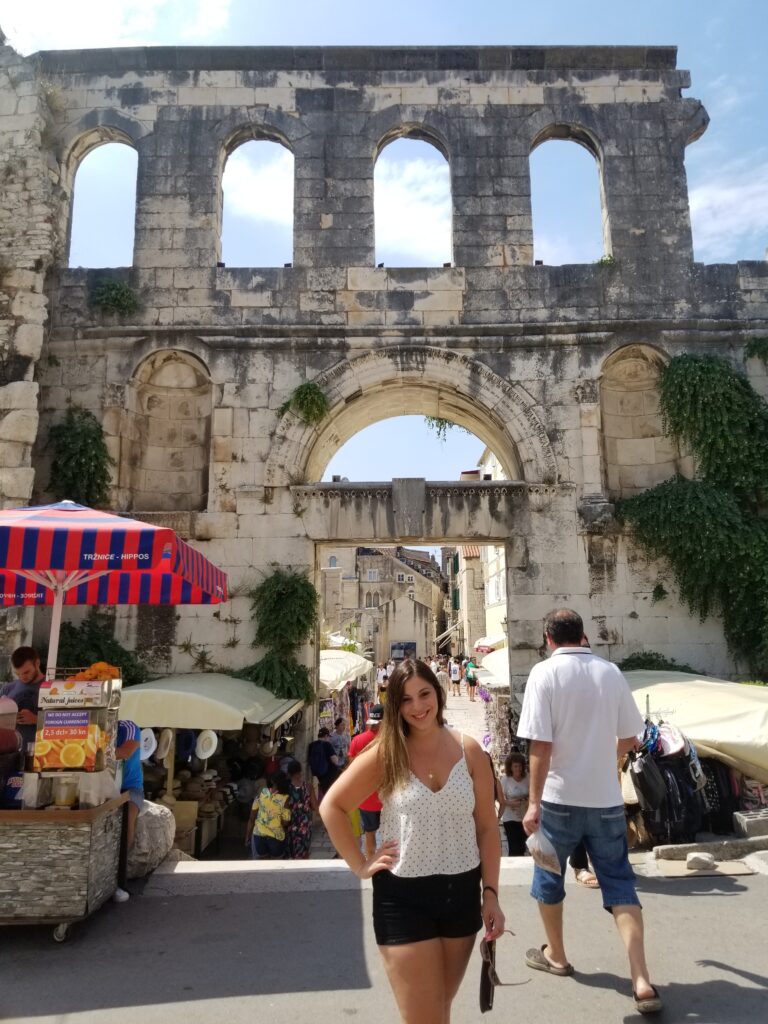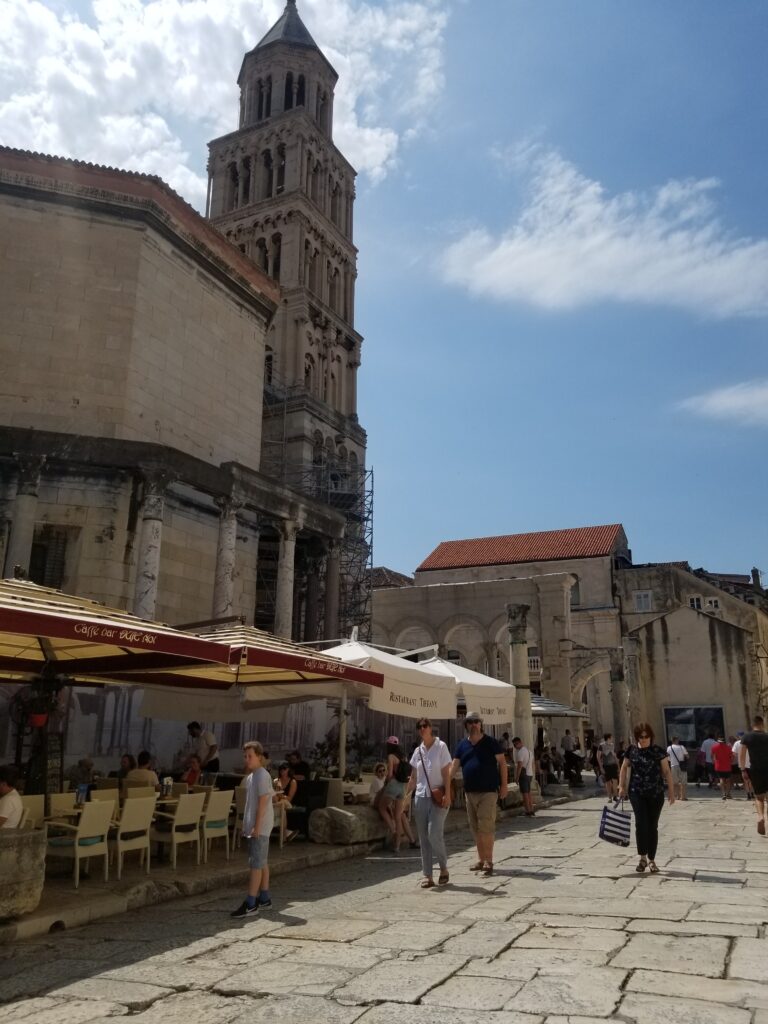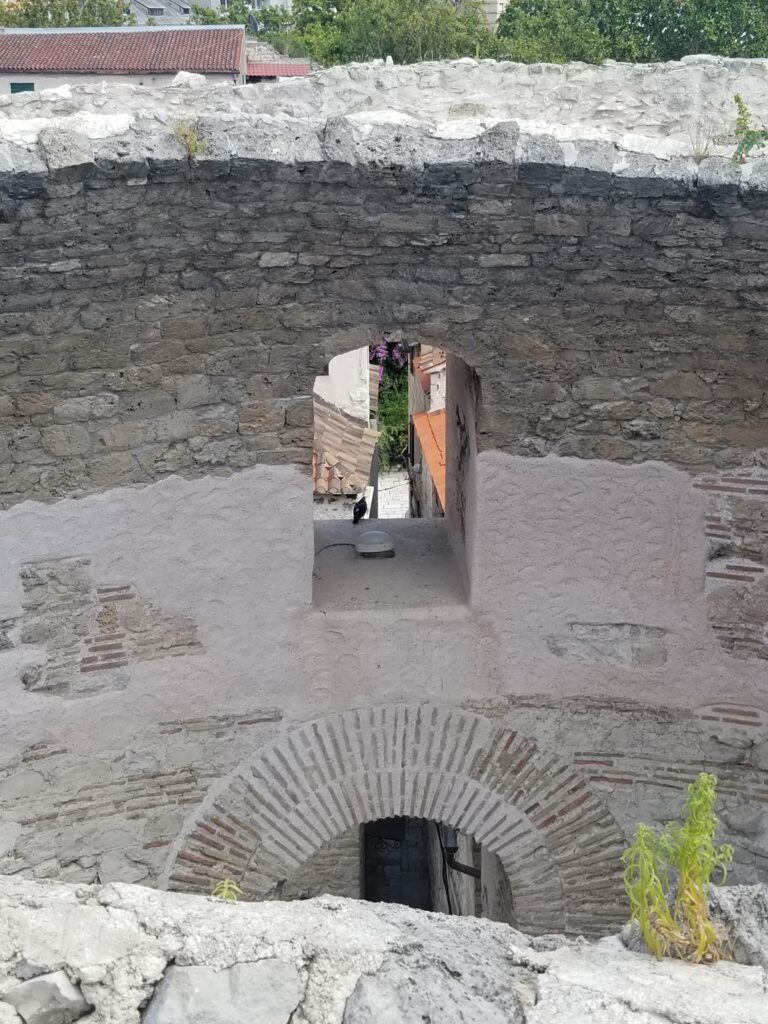After a 12-hour flight, I checked into the Dioklecijan Hotel and Residence in Split, Croatia, showered, changed, and headed to the Diocletian’s Palace. As I arrived at the side of the Palace walls, I walked through the marble-structure and saw the bell tower of the Cathedral of Saint Domnius. I was determined to climb it. (Tourists can catch a bus across the street from the Dioklecijan Hotel and Residence and arrive in the front of the palace. The bus number is 18A.)
The Vestibule of Diocletian’s Palace
I decided to spend some time exploring the Vestibule first as it was less crowded.
The structure is rectangular on the outside, but circular inside. The Vestibule was used as an entrance way into Diocletian’s place and was intended to impress visitors. It is no longer protected by a dome ceiling. The lack-of-ceiling allows for the natural sunlight to flood the space. It reminded me of the time I visited the Pantheon in Rome, Italy.
A “secret” corridor leads to a set of stairs (which are accessible to tourists for the fee of $5 Kuna). The stairs led to a walkway. It encircles the top of the former dome ceiling, which has collapsed. The tower of Saint Domnius Cathedral stands magnificently in contrast to a backdrop of orange rooftops. The fee is definitely worth the view and the lack of tourists who take the time to find the corridor makes the upper-walkway truly worth visiting.
While standing there enamoured by the sheer size of the tower, I overheard tourists speaking in French. They were struggling to capture a “selfie.” I offered to take their photo and they returned the favour.
One particular orange rooftop stood out to me and the rustic, decrepit nature of its appearance seemed “Instagram-worthy.” (Please be sure to follow Cities and Oceans on Instagram for more photos of Split and Croatia).

Inside the Cathedral of Saint Domnius

To enter the Cathedral, tourists are required to pay a fee and visitors are ushered through a “back-door” instead of through the decorative front entrance of the Cathedral.
The Cathedral is dedicated to the Virgin Mary. The bell tower is dedicated to St. Domnius; who was the Bishop of Salona.
Salona was a Roman city that served the capital of the Province of Dalmatia. Saint Domnius went to Rome with Saint Peter. He later went to Dalmatia to evangelize. He was then martyred and religious scholars believe he rests beneath the high alter in the Cathedral.
As I walked to the front of the Cathedral , I reverently apologized for moving across the high-alter area before kneeling. The back-door entrance forces visitors to pass-over the alter before entering the seating area and exiting out the front Cathedral doors. Normally, when I enter a Cathedral, I take a moment to pause, kneel, and say a prayer.
I found an old bench and took a moment to express my gratitude. The opportunity to be in Split, in Croatia, was truly a gift and I took a moment to share my appreciation.

The artistic work of the side alter of St. Anastasius which was created in 1448, by one of the greatest Croatian sculptors known as Juraj Dalmatinac is timeless.
The high altar is also impressive. Giovanni Morlaiter designed the golden angels that adorn the alter in 1767. Above these angels, is a crowned, semi-dome of paintings by Matej Pončun.
The Cathedral Tower of Saint Domnius
It is noteworthy to mention, that I am not claustrophobic but, my mother is. Her description of her claustrophobia has ironically caused me to have anxiety in tight spaces. I looked towards the narrow, steep, dark entrance of the bell tower and said, “Well… here I go…”
As I climbed the stairs, I compared the tower to the one I visited in San Gimignano, Italy in 2015.
However, the stairs in the bell tower of Saint Domnius are steeper and the passageway is narrower. Perhaps, it is because the Cathedral of Saint Domnius is one of the oldest Catholic Cathedrals in the world. It was constructed in 1100 AD and it was reconstructed in 1908 after it collapsed. It is approximately 60 metres tall or 196 feet.
Climbing the original tower stairs was like climbing upwards at a seventy-degree angle, in a chimney (northern Ontario reference) with a smoking fire below, since it was one of the hottest days in Split. I felt drenched in sweat and I commended myself for my fit-bit steps.
I became more confident in my “strides” and came to a plateau area where the stairs shifted into a modern, scaffolding stairway. The fresh air filtered through the sides of the tower and made for an easier climb to the top where other tourists awed at the sites – a beautiful harbour filled with ships and an orange sea of rooftops.
The top of the Tower: Cathedral of Saint Domnius
The crystal-clear blue water was in sharp contrast to the orange rooftops that I had hoped to see while visiting Croatia. The water reminded me of Tropea, Italy.
A sudden surge of joy ran through me and I felt like my journey to Croatia had officially began. I asked my friends from France to snap a few photos for me.
As I descended, I remember hearing a child yell in French behind me, “J’ai peur, Papa!” (“I am scared, Papa!”) Unfortunately, I could not respond to this child as I do not speak french well, but I wanted to yell, “Me too!” Going down the stairs was much more terrifying then going up!
After descending the modern scaffolding stairs, I I slinked myself down the sleek, stone steps as if I were a snail in order to avoid hitting my head on the ceiling or slipping to the bottom.
Stepping out of the corridor and into the sunshine, I took a deep breath. Another tower visited and survived. The beautiful photos serve as a reminder of one of the most-iconic look out spots in Croatia’s second largest city.
I highly recommend the climb when you visit Split! #onegirlsjourney #citiesandoceans














